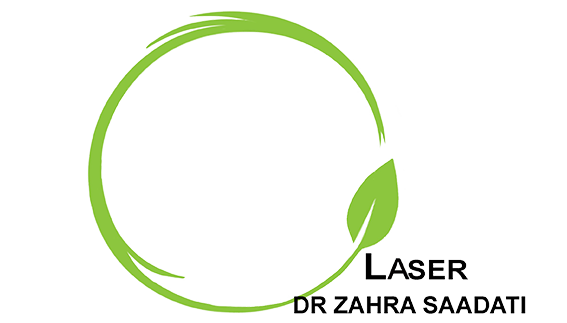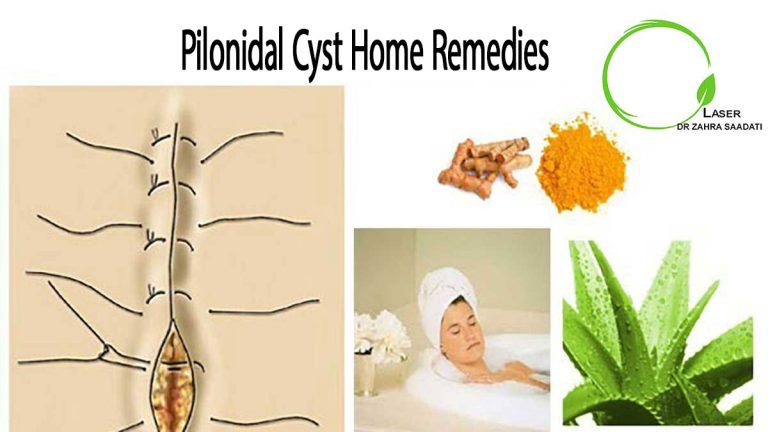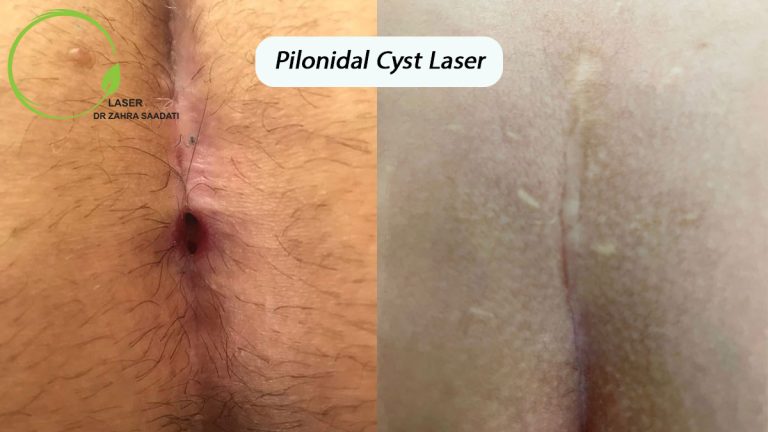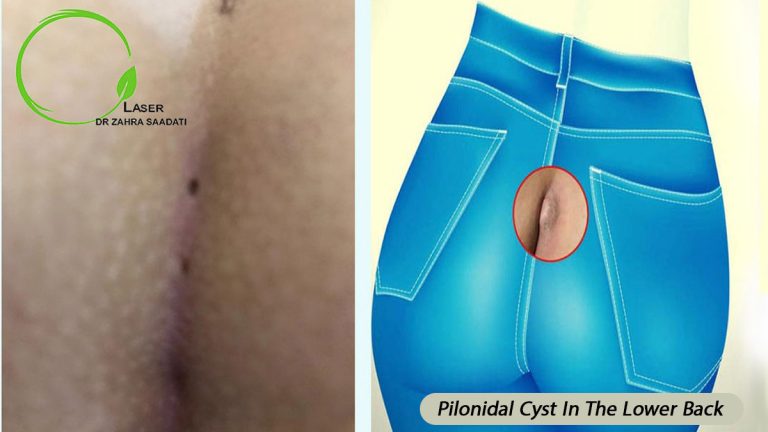Depending on the surgeon’s proficiency, pilonidal sinus surgery may be performed with different tools such as the high-power laser, cauters, and blades. The basic principle of pilonidal sinus surgery is to drain the cyst in a way to minimize the risk of its recurrence. Pilonidal sinus surgery is performed either open or closed. Pilonidal sinus closed surgery requires the high proficiency of the surgeon to reduce the risk of recurrence and leave no scar.
A pilonidal cyst in the lower back occurs at the end of the spine near the sacrum. A pilonidal sinus is a cyst containing dead remains of the skin, pus, and hair that opens a hole to the outside of the skin after a short period. However, the content of this cyst is not easily excreted, unless it is drained by a surgeon during a surgical procedure. Pilonidal sinus surgery is performed in two ways: open or closed.
Pilonidal cyst surgery is usually performed in four stages:
- The place of the pilonidal cyst becomes numb
- The cyst wall is destroyed with a surgical blade, cautery or high-power laser, and the contents of the cyst are drained.
- The wound is filled with a pressure dressing or closed with stitches
- It takes four weeks for the wound to heal and the pressure dressing is changed daily

Which one is a better,pilonidal sinus laser surgery or conventional surgery?
The high-power CO2 laser is currently the most advanced tool used for pilonidal sinus surgery. The pilonidal sinus laser is very superthin and makes delicate incisions. Since the laser repairs the head of the affected vessels and nerves at the same time, this method of surgery causes the minimum pain and bleeding. This is quite opposite of conventional surgery with blades and cauters.
A disadvantage of pilonidal sinus surgery with cauters is that they burn a large part of healthy tissue and also cause severe pain and irritation. Conventional surgery with blades also causes severe pain and bleeding. In addition, these two tools cannot make incisions as delicate as the laser can.
Pilonidal sinus laser surgery requires high experience and proficiency, and a general surgeon who wants to perform laser surgery should pass training courses in laser surgery.
It is noteworthy that Dr. Zahra Saadati, a general surgeon and laser surgery specialist, has passed specialized training courses in laser surgery in Russia, Türkiye, and Iran and has been performing laser surgery since 2007. She also participates in relevant courses and conferences throughout Iran and the world and always employs the latest proven methods for the treatment of patients with pilonidal sinus, anal fistulas, hemorrhoids, anal fissures, and anorectal abscesses.
Pilonidal sinus surgery can be performed by using different tools in two ways: open and closed. However, it is recommended to undergo closed surgery using a high-power laser.
Pilonidal sinus open surgery
Pilonidal sinus surgery is called open when the pilonidal sinus is removed in a cystectomy and the wound is not sutured the remaining cavity of the cyst is filled with a dressing. Patients who select this surgery method will go through a very tough and long recovery period (at least two months) that requires everyday changing of wound dressing and postoperative care.
This expensive procedure is commonly employed in regions where physicians and surgeons are not experienced and proficient enough to perform closed or laser surgery. The longer the wound healing takes, the higher the risk of recurrence of pilonidal sinus will be. Therefore, the 2-month recovery period after pilonidal sinus open surgery is considered a golden time for patients.

Pilonidal sinus closed surgery
As the name implies, the wound is sutured after removing the cyst in this treatment of pilonidal sinus. There are different methods for suturing the wound resulting from pilonidal sinus surgery, two of which are described here: plastic surgery with laser and the Limberg flap.
Pilonidal sinus plastic surgery with laser
In some cases, the general surgeon and laser surgery specialist makes a tiny hole and pushes the fiber laser into the wound in order to destroy the cyst wall without rupturing it. When a pilonidal sinus is decided to be treated by a closed cystectomy, it is recommended to perform this procedure using the high-power laser because the use of laser equipment for this purpose minimizes the risk of recurrence (almost zero) and shortens the recovery period.
Pilonidal sinus Limberg flap surgery
This method of surgery may be done with or without laser equipment. Since this method leaves a very large scar, the resulting wound should be sutured in a way different from that of plastic surgery. This method is not much popular among patients because of the large incision it makes on the skin. In addition, the risk of recurrence in this method is higher than in other methods. This method of pilonidal sinus surgery requires large sutures that may leave a Z-shaped scar on the patient’s skin.
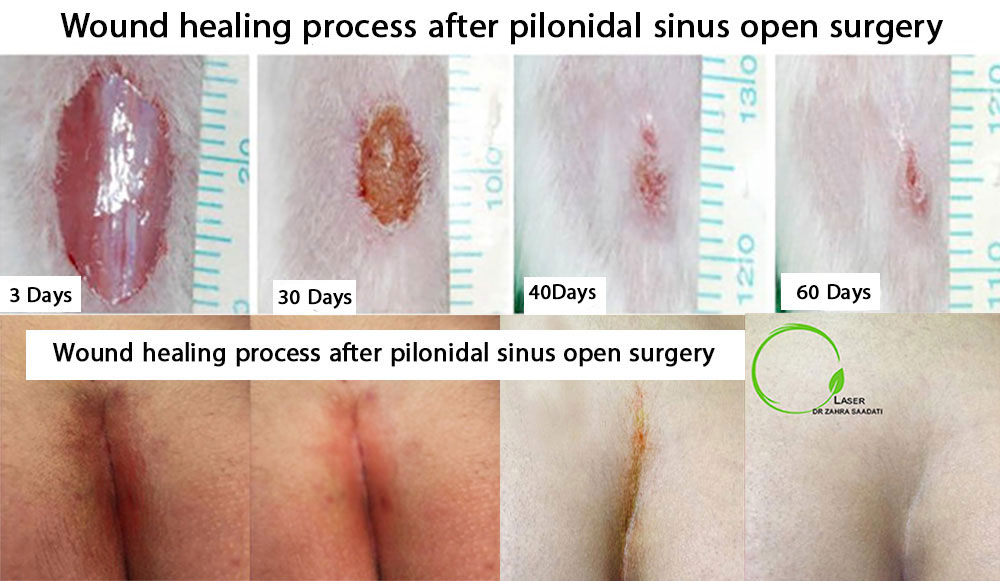
Care after pilonidal sinus surgery
The postoperative care and the length of the recovery period depend on the surgery method (i.e. open or closed). The most important care for all patients undergoing pilonidal sinus surgery, regardless of its method, is to regularly remove excess hair from the anal area. The best way to do so is laser hair removal. Be sure that no hair remains inside the wound if you shave the hair with a razor. In addition, use sterilized tweezers to remove the hair that is not removed with a razor or depilatory medicine. It is not recommended to use depilatory powders or creams for this purpose because they may damage the skin and tissue around the anus. All patients undergoing pilonidal sinus surgery should wash and clean the surgical site every day. However, those with an open wound need to do so very carefully and then renew the wound dressing. By contrast, those with a closed wound only should wash the area.
Patients who treat their pilonidal sinus with closed laser surgery can return to their workplaces 2 or 4 days after surgery, whereas those who undergo open surgery should go through a recovery period of 1 to 2 months. If you have a sedentary job, it is recommended to sit on a soft pillow to reduce pressure on the surgical site. It is also better to use a toilet for defecation.
A video of pilonidal sinus surgery
Frequently asked questions (FAQs) about pilonidal sinus surgery
1-Is it possible to sit after pilonidal sinus surgery?
If you undergo pilonidal sinus closed surgery with laser, you need to lie down on the back seat of the car all the way home and rest at home for only one night. You can sit from the next day but you should be careful not to sit on hard surfaces or for a long time at least within the first week. If you undergo open surgery, you cannot sit for one to four weeks, and it is better to lie down in a prone position to reduce pressure on the surgical site.
2-Is pilonidal sinus surgery a painful procedure?
You will feel no pain during surgery because it is performed under general or spinal anesthesia. The severity of postoperative pain depends on the surgery method. If an experienced surgeon treats your pilonidal sinus through closed surgery with laser, you will feel mild pain after surgery that can be easily relieved with simple painkillers. By contrast, if you undergo conventional surgery, you may have to use painkillers for up to a week.
3-Is pilonidal sinus surgery the only definitive treatment for this disease?
Yes, all types of pilonidal sinus should be drained in a surgical procedure. Since it is not possible to definitively treat a pilonidal sinus through medication, there is no other option but pilonidal sinus surgery. Closed laser surgery is the best method for this purpose.
4-Is pilonidal sinus a deadly disease?
Some people may put up with a pilonidal sinus for years because of their fear of surgery. A pilonidal sinus in advanced cases leads to abscesses and infections, and untreated abscesses may also cause multiple complicated fistulas. Finally, they suffer from severe systemic infections. Such individuals will ultimately visit a general surgeon when they feel intolerable pain. It can be hence concluded that a pilonidal sinus itself does not lead to death, but repeated and untreated infections may take the lives of such patients.
5-How can one use a toilet after pilonidal sinus surgery?
Regardless of the pilonidal sinus surgery method (open or closed), note that you should defecate or urinate in a way that puts no pressure on the surgical site. The best solution is to use a toilet to reduce pressure on the anal area and the back skin stretch.
6-How should patients sleep after pilonidal sinus surgery?
After pilonidal sinus surgery, you can sleep in a lateral or prone position. The general surgeon may recommend the patient sleep in a supine position during the first three days after surgery. However, this cannot be advised to all patients and most of them are generally recommended not to put pressure on the surgical site.
7-Is it possible to treat pilonidal sinus by a nonsurgical procedure?
If you are diagnosed with a pilonidal sinus by a general surgeon, the only definitive treatment is the surgical drainage of the cyst. In fact, it is not possible to definitively treat a pilonidal sinus with medication or other methods. The best method for treating this disease is closed laser surgery.
8-What should we eat after pilonidal sinus surgery?
After pilonidal sinus, it is recommended to eat high-fiber foods to have easy defecation and reduce pressure on your lower back during this process. Moreover, honey, aloe vera, avocado, pineapple, and fruits rich in vitamins and minerals will help wound healing.
9-What are the symptoms of infection after pilonidal cyst surgery?
If you have foul-smelling secretions with pain, and the patient’s secretions and pain increase day by day, it is a sign of infection after pilonidal cyst surgery. Colorless and odorless secretions are normal and will decrease day by day after pilonidal cyst surgery.
